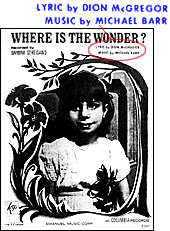 Barbra Streisand's recording of "Where Is The Wonder" was included on her album My Name Is Barbra, and was given a choice spot immediately before "People" in her TV special of the same name. The joint launching of the album and special in the spring of 1965 helped cement Streisand's final ascent to superstardom, and went on to win her a Grammy and two Emmies. "Where Is The Wonder" was also released in '65 as the B-side to her single "My Man," and the same version reappeared three years later as the B-side to yet another Streisand single, "The Morning After" (not the Maureen McGovern/Poseidon Adventure song).
Barbra Streisand's recording of "Where Is The Wonder" was included on her album My Name Is Barbra, and was given a choice spot immediately before "People" in her TV special of the same name. The joint launching of the album and special in the spring of 1965 helped cement Streisand's final ascent to superstardom, and went on to win her a Grammy and two Emmies. "Where Is The Wonder" was also released in '65 as the B-side to her single "My Man," and the same version reappeared three years later as the B-side to yet another Streisand single, "The Morning After" (not the Maureen McGovern/Poseidon Adventure song).For songwriters, a cut by the likes of a BARBRA STREISAND (pictured: sheet music for "Where Is The Wonder") could be the ticket to a rich and lasting career. But the way things turned out for McGregor and Barr, it was to be their pinnacle. Nobody is quite sure what went wrong. Part of the problem was that McGregor, while a talented stylist of what he termed "jazz ballads," wasn't a driven man, preferring to sit around and watch or talk about old movies than to push his songwriting career. Cobert feels that he suffered from "a desire to not succeed," that the demands and trappings of success would have intruded on the comfort of McGregor's day-to-day lifestyle. "He would have been very unhappy if [Frankie And Johnny] had happened and he had to be involved," Cobert says, but he acknowledges that "Dion was a fabulous lyric writer" and agrees with others that his steady string of near-misses was mostly down to simple bad luck.
The Streisand song earned McGregor and Barr a few grand apiece for a couple of years but only, according to Barr, "dribs and drabs" ever since. McGregor had no money and no steady job, taking on little more than the occasional freelance project that could draw on his encyclopedic knowledge of movies. He was hired, for instance, to organize and inventory a huge collection of old movie posters; he worked for a while at a movie memorabilia store (The Memory Shop, cited in the somniloquy "A City So Nice"); he helped edit a major film reference book (nobody I contacted, including McGregor himself, could agree on which one it was); he helped compile a "picture biography" of Greta Garbo, published in 1963 by Citadel Press. (One job, at least, had nothing to do with film, and rather sounds like a scene from one of his somniloquies. He was hired for a while to do marketing interviews by telephone, and told his friends that for one particular survey he was required to ask women, "Which way do you wipe?") But McGregor's survival needs were modest, and as long as he had friends and they had couches, his charm and wit allowed him about all the material privilege that he required.
SKIPPY GREEN! SKIPPY GREEN!
![]()
CD home page:
![]()
DION McGREGOR DREAMS AGAIN
 HE TEAM OF McGregor and Barr was rising up the songwriting ladder in steady measures. In 1962 Barr hustled himself down to the studio of The Today Show when he heard that his favorite young singer, Barbra Streisand, would be appearing on the live TV program that very morning. He caught up with her and her manager, Marty Erlichman, at the elevator, where he handed her the lead sheets to three of their recent songs. Streisand looked them over and responded favorably to one of them, "Where Is The Wonder," on the spot. But it took a year before Erlichman called to say that Streisand was ready to publish and record "Where Is The Wonder," and at that only if the team accepts a contract granting them half of the already publisher-friendly standard minimum. According to Chandler Warren, the attorney Barr and McGregor hired to negotiate the deal, "Erlichman said, ‘We've gots lots of songs. If you want her to sing your fine song, you'll sign the contract. If you don't, we'll get another song.'" They signed the contract.
HE TEAM OF McGregor and Barr was rising up the songwriting ladder in steady measures. In 1962 Barr hustled himself down to the studio of The Today Show when he heard that his favorite young singer, Barbra Streisand, would be appearing on the live TV program that very morning. He caught up with her and her manager, Marty Erlichman, at the elevator, where he handed her the lead sheets to three of their recent songs. Streisand looked them over and responded favorably to one of them, "Where Is The Wonder," on the spot. But it took a year before Erlichman called to say that Streisand was ready to publish and record "Where Is The Wonder," and at that only if the team accepts a contract granting them half of the already publisher-friendly standard minimum. According to Chandler Warren, the attorney Barr and McGregor hired to negotiate the deal, "Erlichman said, ‘We've gots lots of songs. If you want her to sing your fine song, you'll sign the contract. If you don't, we'll get another song.'" They signed the contract.